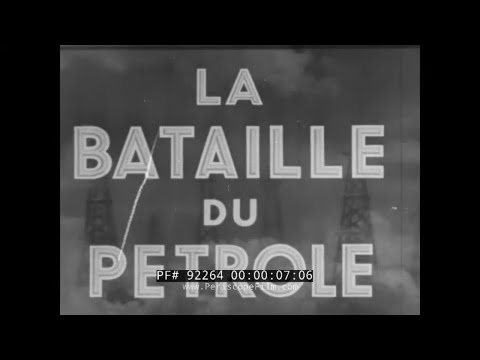Want to support this channel and help us preserve old films? Visit https://www.patreon.com/PeriscopeFilmBrowse our products on Amazon: https://amzn.to/2YILTSD“Battle for Oil” is a WWII Canadian propaganda film from 1942. The film was produced by Raymond Spottiswoode and directed by Stuart Legg. This version is in French. The film examines oil production and supply and shows its priority as part of the war effort. It shows how the Royal Air Force and U.S. Army Air Forces are raiding production facilities that supply Nazi Germany with oil, and vice versa. This made refineries, synthetic fuel factories and storage depots prime strategic targets. The film opens with a sign about rationing that reads “Avoid Useless/Non-essential Driving” as a crack down on fuel use domestically was used to conserve oil for warfare (:19). Commuters took to carpooling or riding bicycles (:34) and a curfew was imposed to keep drivers off the road as much as possible. A map is shown pointing to Venezuela, Texas and Mexico which comprise the largest oil basin in the world (1:06). Men hold long pipes pumping oil into ships (1:06) to power countries like the US and Britain’s naval fleets. To protect oil supplies and gateways against U-boats, American warships (1:26) were sent out and patrol bombers flew over the Gulf of Mexico (1:30). Another main source of oil was the Great Central Eurasian oilfield which Soviet troops and tankers (including one marked "Lenin") (1:45) fought to protect from German onslaught (1:49). British and French troops maintained guard over Middle Eastern oil supplies such as in Iraq and Syria (2:08). Fighting breaks out over the area with Italian Savoia-Marchetti SM.79 Sparviero bombers overhead. The British respond with anti-aircraft weapons and sub-machinegun fire (2:24). Gasoline containers are sent down from a ship in an assembly line fashion in Iran (2:42). Rare footage of Reza Shah is photographed riding horseback and then with his son, the future Shah Mohammad Reza Pahlavi (2:46). (The British would encourage Reza Shah's overthrow and replacement by his son in 1941 as part of the Anglo-Soviet invasion of Iran.) British ships previously relied on coal for fueling and to keep them moving, they had to set up refueling locations depicted on a map (4:46). Workers in a ship yard construct redesigned ships to become oil tankers (5:02) as so ordered by Winston Churchill. The battle against the Kriegsmarine's battlecruiser SMS Bismarck follows as on May 27th, 1941, through Morse code (6:15) the Royal Navy received warning of the Bismarck in North Atlantic waters (6:43). Swordfish torpedo bombers take off from the aircraft carrier Ark Royal (6:43) and after heavy attack, the Bismarck was destroyed. Nazi planes are shown as they are refueled (7:51). Germany had little oil of its own and other sources were limited (8:25). This led to the construction of 25 oil plants (8:31) in order to power their military (8:42). An automobile center and empty gas station (9:05) are shown as rigid restrictions on fuel left much of Europe drained of supply. This led to many German’s using horse and plow for farm work (9:08). Fighting between the Russians and Germans broke out as Russia had vast oil reserves (9:32). The RAF plotted an attack on German synthetic oil facilities (11:01) and torpedoes are seen dropped over Germany (11:22) including a massive explosion of two large oil drums (11:26). In Britain, troops stand with eyes and guns pointed to the skies (12:02) as they knew they must also protect their own supply. Inside a factory, long range bombers are seen constructed (12:14) and armored division tanks riding over slopes into water follow (12:26). Secretary of the Interior Harold Ickes stood as the U.S.A.’s controller of oil and speaks on how the war was being fought over oil and would be won with oil (13:44). The White House is shown (14:00) as the US sought to preserve their own oil to send to Britain as part of Lend-Lease, and this led to fuel use restrictions and rationing. A tank reading ‘Imperial’ (14:23) in Canada points to how Canada was also imposing restrictions as well as reserving tanker space. Pipelines were installed (14:44) as Canada sought to expand it’s oil fields in Turner Valley (15:33). The film concludes and was a Distribution France Film (16:31). We encourage viewers to add comments and, especially, to provide additional information about our videos by adding a comment! See something interesting? Tell people what it is and what they can see by writing something for example: "01:00:12:00 -- President Roosevelt is seen meeting with Winston Churchill at the Quebec Conference."This film is part of the Periscope Film LLC archive, one of the largest historic military, transportation, and aviation stock footage collections in the USA. Entirely film backed, this material is available for licensing in 24p HD, 2k and 4k. For more information visit http://www.PeriscopeFilm.com
